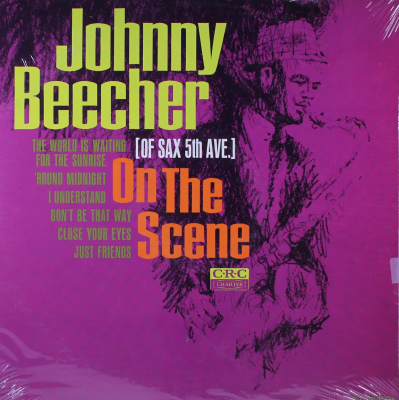.
.
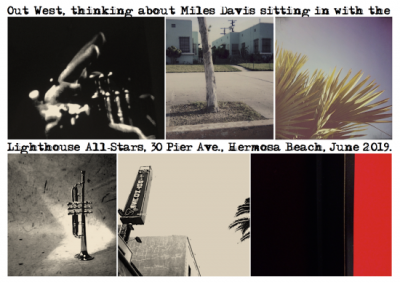
.
“Out West, Thinking about Miles Davis” is one of several photo-narratives in Charles Ingham’s new series devoted to his love of jazz music, “Charles Ingham’s Jazz Narratives”
These photo-narratives are provocative and meaningful– connecting time, place, and subject in a way that ultimately allows the viewer a unique way of experiencing jazz history.
To enhance the opportunity for appreciation of this artistic series, in the coming weeks “Charles Ingham’s Jazz Narratives” will be featured on Jerry Jazz Musician three-at-a-time, and will include the artist’s description of each piece.
.
.
This edition’s narratives, found below the artist’s introduction, are:
.
“Exactly Where She Is Supposed to Be”
“In Memory of Clora Bryant, Standing Outside the Downbeat”
“Out West, Thinking About Miles Davis”
.
.
_____
.
.
Charles Ingham introduces his “Jazz Narratives” series
.
…..Jazz has always been there for me. Music is an essential part of my life, and I have eclectic tastes, but there has always been jazz music. At seventeen, I’m at a Rahsaan Roland Kirk concert in my hometown of Manchester, England, stunned by the transgressive beauty of this man’s performance. At fifty-seven, my wife has died, and I can’t bear to hear lyrics, so it’s Kind of Blue and Trane ballads. And today I’m listening to ‘Round Midnight, Monk alone at the piano, stunningly honest and almost unbearably intimate.
…..So as an artist I need to give something back, but make it my own, and make it new.
…..As a conceptual artist, my photo-narratives are hybrid forms, transgressing distinctions between the verbal and the visual: the image as text. My art represents a combinatory aesthetic; each work constitutes a whole made up of parts, creating something of a symbiosis: the words, the images (abstract and referential), the space between images, the subjects, the reference to specific individuals, places, or times. As the artist Alexis Smith says of her collages and assemblages: “It’s fused into a whole where they seem like they’ve always been together, or were meant to be together. The people that look at them put them together in their heads.” Some visual references are obvious; some of the bones, sinews, and other connective tissue that hold a particular narrative together work within the piece’s own logic, a logic that viewers find for themselves. Here, the artist makes the work, and that work has an agenda, but a significant part of that agenda is for the viewer to find something of (or for) themselves within these images and words.
…..Each work in this series of “Jazz Narratives” is anchored by a person (a musician) and a related place. I am especially interested in the “aura” of these places. Sometimes, the place remains relatively unchanged seventy years after the musical fact; sometimes, only a physical street number remains, if that. What matters is that, for the artist and the viewer, this aura remains. This, say, is 151 Avenue B, on the Lower East Side; the brownstone is easy to miss if you are walking along the east side of Tomkins Square Park, but if you know that Charlie Parker lived there, it has become something more than the stone and glass of the place. 4201 S. Central Avenue, Los Angeles, is an anonymous mixed-use building, but there’s the number above the glass doors; 4201 S. Central is the Downbeat Club. Here, in 1945, Clora Bryant first heard bebop: here, on this corner, and that corner is still here, as is that night and all those other nights.
…..Some years ago in Brooklyn, I went looking for 99 Ryerson Street, where the poet Walt Whitman had lived when Leaves of Grass was first published. The fact that Whitman had lived here had only recently been discovered, and the 1850s wood-frame house was unmarked and unchanged except for aluminum siding and the addition of an extra floor. It is the only surviving Whitman residence in Brooklyn and Manhattan. Standing on the original bluestone sidewalk slabs, I was looking at Whitman, whose vision of America was a primary reason for my decision to emigrate to the United States. In my excitement, I crossed the street and spoke to an elderly man sitting on the stoop opposite. “Do you know that Walt Whitman lived in that house?” I asked, clearly appearing to be a madman. The neighbor looked up at the crazy person: “Is that the guy who is renting a room?” For him, the aura was not visible.
…..These pieces are works of homage; I am making some kind of unsentimental pilgrimage to each of these apparently anonymous street addresses. And I am conjuring ghosts; they are still alive in these places as they are in their recordings. The music may have been recorded in 1947, but they are playing it now. You can hear that. And, if I am successful, you can see the musicians in my art.
.
_____
.
.
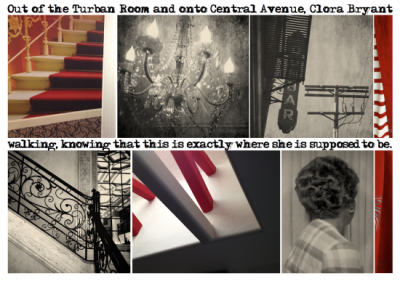
.
Exactly Where She Is Supposed to Be
(4225 S. Central Ave., Los Angeles)
2019
.
…..
…..
…..The trumpet player Clora Bryant leaves the Turban Room, a lounge inside the Dunbar Hotel. “[W]here she is supposed to be” is a quotation from Bryant herself in the book Central Avenue Sounds, where she reflects on her arrival in LA from Texas, and her realization that Central Avenue, with its music (and everything else), is exactly where she is supposed to be – she is home.
…..For many years the only major Los Angeles hotel welcoming African Americans, the Black-owned Dunbar was built by Black contactors, laborers, and craftsmen, and financed by Black community members. The Dunbar served as the elegant anchor to the Central Avenue community of the 1930s and 1940s. No longer a hotel, the 1928 building still stands.
…..Born in 1927, Clora Bryant died, aged 92, in Los Angeles on the 25th of August, 2019. I made this work in the first week of August of that year.
.
.
___
.
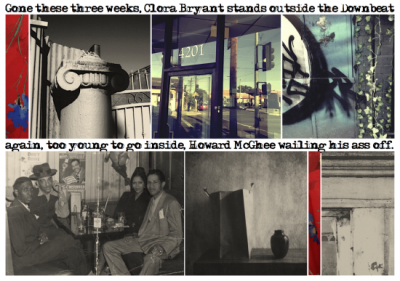
.
In Memory of Clora Bryant, Standing Outside the Downbeat
(4201 S. Central Ave., Los Angeles)
2019
.
…..
…..I made my work paying homage to Clora Bryant “Exactly Where She Is Supposed to Be” in the first week of August, 2019. On the 2nd of September, Labor Day, my wife looked up from her iPad and announced, “Clora Bryant has died.”
…..Aged 92, Bryant had died on August 25th .
…..I don’t know what clichés to use here to describe my reaction to the news, and there’s a bunch of them, but I don’t think that I need to draw on any of them here. You get it. And, on that Monday at the beginning of September, her Gal with a Horn CD gets played.
…..So here is another – posthumous – homage to Clora Bryant.
…..Bryant talks of arriving in Los Angeles in 1945, and of standing with her brother outside the.Downbeat, listening: “I couldn’t go in. I was under age. That was the first time I’d heard bebop.live in L.A. I couldn’t figure out what they were doing. Howard [McGhee] was a very good trumpet player. He was wailing his ass off. I said, ‘My God, what is this?’” (Central Avenue Sounds: Jazz in Los .Angeles.)
…..May you rest in peace, Clora Bryant. And thank you for so much.
.
___
.

.
.
Out West, Thinking About Miles Davis
(30 Pier Ave., Hermosa Beach, California)
2019
.
…..
…..In 1953, Max Roach and Charles Mingus picked up Miles Davis at his father’s house in East St. Louis and drove out to California, Roach was booked to take Shelly Manne’s place in the Lighthouse All-Stars. Miles would sit in on various occasions with the All-Stars.
…..In West Coast Jazz, Ted Gioia notes, “The various live recordings suggest that the Lighthouse was no .center for California cool but was as boisterous and lively a setting for jazz music as any.dive found east or west. . . Whatever introspective tendencies West Coast jazz may have had, they.rarely took wing in this high-energy environment.”
…..It was in the Lighthouse on Roach’s birthday that Davis would have a fight with a bartender. As the two.men crashed into tables and customers and continued the fight, Max Roach carried on playing.
.
.
All pieces are archival inkjet prints, 4½ x 6½ inches, framed to 14 x 14 inches. For more information, visit charlesingham.com
.
.
To see Volume 1 of this series, click here
To see Volume 2 of this series, click here
To see Volume 3 of this series, click here
To see Volume 4 of this series, click here
To see Volume 5 of this series, click here
To see Volume 6 of this series, click here
To see Volume 7 of this series, click here
To see Volume 8 of this series, click here
To see Volume 9 of this series, click here
.
___
.
.
photo by Jacqueline Ramirez
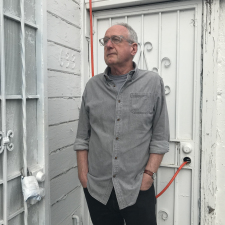
.
Born and educated in England, Charles Ingham moved to California in 1982. He has always been interested in hybrid forms and the intersection of literature and the visual arts, his photography often seeking to transgress the traditional boundaries separating the verbal and the visual.
Ingham lives in San Diego and shows his work at Distinction Gallery in Escondido. He recently had three pieces accepted for the 28th Annual Juried Exhibition at the Athenaeum Music and Arts Library, La Jolla. He also had two pieces shown in the “Six-Word Story” exhibitions at Front Porch Gallery, Carlsbad, and the Oceanside Museum of Art.
His work can be found.at his website: charlesingham.com
.
.
.
.
.
.</span







